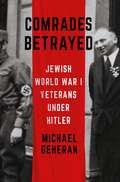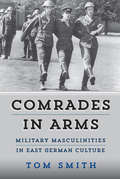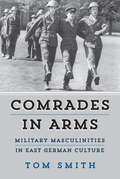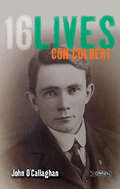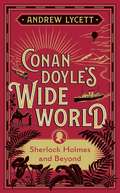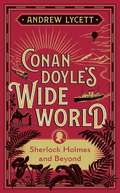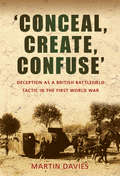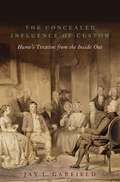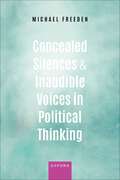- Table View
- List View
Comrades and Strangers: Behind the Closed Doors of North Korea
by Michael HarroldIn 1987 Michael Harrold went to North Korea to work as English language adviser on translations of the speeches of the late President Kim Il Sung (the Great Leader) and his son and heir Kim Jong Il (then Dear Leader and now head of state). For seven years he lived in Pyongyang enjoying privileged access to the ruling classes and enjoying the confidence of the country’s young elite. In this fascinating insight into the culture of North Korea he describes the hospitality of his hosts, how they were shaken by the Velvet Revolution of 1989 and many of the fascinating characters he met from South Korean and American GI defectors to his Korean minder and socialite friends. After seven years and having been caught passing South Korean music tapes to friends and going out without his minder to places forbidden to foreigners, he was asked to leave the country.
Comrades Betrayed: Jewish World War I Veterans under Hitler (Battlegrounds: Cornell Studies in Military History)
by Michael GeheranAt the end of 1941, six weeks after the mass deportations of Jews from Nazi Germany had begun, Gestapo offices across the Reich received an urgent telex from Adolf Eichmann, decreeing that all war-wounded and decorated Jewish veterans of World War I be exempted from upcoming "evacuations." Why this was so, and how Jewish veterans at least initially were able to avoid the fate of ordinary Jews under the Nazis, is the subject of Comrades Betrayed. Michael Geheran deftly illuminates how the same values that compelled Jewish soldiers to demonstrate bravery in the front lines in World War I made it impossible for them to accept passively, let alone comprehend, persecution under Hitler. After all, they upheld the ideal of the German fighting man, embraced the fatherland, and cherished the bonds that had developed in military service. Through their diaries and private letters, as well as interviews with eyewitnesses and surviving family members and records from the police, Gestapo, and military, Michael Geheran presents a major challenge to the prevailing view that Jewish veterans were left isolated, neighborless, and having suffered a social death by 1938. Tracing the path from the trenches of the Great War to the extermination camps of the Third Reich, Geheran exposes a painful dichotomy: while many Jewish former combatants believed that Germany would never betray them, the Holocaust was nonetheless a horrific reality. In chronicling Jewish veterans' appeal to older, traditional notions of comradeship and national belonging, Comrades Betrayed forces reflection on how this group made use of scant opportunities to defy Nazi persecution and, for some, to evade becoming victims of the Final Solution.
Comrades in Arms: Military Masculinities in East German Culture
by Tom SmithWithout question, the East German National People’s Army was a profoundly masculine institution that emphasized traditional ideals of stoicism, sacrifice, and physical courage. Nonetheless, as this innovative study demonstrates, depictions of the military in the film and literature of the GDR were far more nuanced and ambivalent. Departing from past studies that have found in such portrayals an unchanging, idealized masculinity, Comrades in Arms shows how cultural works both before and after reunification place violence, physical vulnerability, and military theatricality, as well as conscripts’ powerful emotions and desires, at the center of soldiers’ lives and the military institution itself.
Comrades in Arms: Military Masculinities in East German Culture
by Tom SmithWithout question, the East German National People’s Army was a profoundly masculine institution that emphasized traditional ideals of stoicism, sacrifice, and physical courage. Nonetheless, as this innovative study demonstrates, depictions of the military in the film and literature of the GDR were far more nuanced and ambivalent. Departing from past studies that have found in such portrayals an unchanging, idealized masculinity, Comrades in Arms shows how cultural works both before and after reunification place violence, physical vulnerability, and military theatricality, as well as conscripts’ powerful emotions and desires, at the center of soldiers’ lives and the military institution itself.
Comrades in conflict: Labour, the trade unions and 1969's In Place of Strife
by Peter DoreyOn the 50th anniversary of In Place of Strife, this scholarly study makes extensive use of previously unpublished archival and other primary sources to explain why Harold Wilson and Barbara Castle embarked on legislation to regulate the trade unions and curb strikes, and why this aroused such strong opposition, not just from the unions, but within the Cabinet and among backbench Labour MPs. This opposition transcended the orthodox ideological divisions, making temporary allies of traditional adversaries in the Party. Even Wilson’s threats either to resign, or call a general election, if his MPs and Ministers failed to support him and Castle, were treated with derision. His colleagues called Wilson’s bluff, and forced him to abandon the legislation, in return for a ‘solemn and binding’ pledge by the trade unions to ‘put their own house in order’ in tackling strikes.
Comrades in conflict: Labour, the trade unions and 1969's <i>In Place of Strife</i>
by Peter DoreyOn the 50th anniversary of In Place of Strife, this scholarly study makes extensive use of previously unpublished archival and other primary sources to explain why Harold Wilson and Barbara Castle embarked on legislation to regulate the trade unions and curb strikes, and why this aroused such strong opposition, not just from the unions, but within the Cabinet and among backbench Labour MPs. This opposition transcended the orthodox ideological divisions, making temporary allies of traditional adversaries in the Party. Even Wilson’s threats either to resign, or call a general election, if his MPs and Ministers failed to support him and Castle, were treated with derision. His colleagues called Wilson’s bluff, and forced him to abandon the legislation, in return for a ‘solemn and binding’ pledge by the trade unions to ‘put their own house in order’ in tackling strikes.
Comrades in conflict: Labour, the trade unions and 1969's <i>In Place of Strife</i>
by Peter DoreyOn the 50th anniversary of In Place of Strife, this scholarly study makes extensive use of previously unpublished archival and other primary sources to explain why Harold Wilson and Barbara Castle embarked on legislation to regulate the trade unions and curb strikes, and why this aroused such strong opposition, not just from the unions, but within the Cabinet and among backbench Labour MPs. This opposition transcended the orthodox ideological divisions, making temporary allies of traditional adversaries in the Party. Even Wilson’s threats either to resign, or call a general election, if his MPs and Ministers failed to support him and Castle, were treated with derision. His colleagues called Wilson’s bluff, and forced him to abandon the legislation, in return for a ‘solemn and binding’ pledge by the trade unions to ‘put their own house in order’ in tackling strikes.
Comrades of Color: East Germany in the Cold War World (Protest, Culture & Society #15)
by Quinn SlobodianIn keeping with the tenets of socialist internationalism, the political culture of the German Democratic Republic strongly emphasized solidarity with the non-white world: children sent telegrams to Angela Davis in prison, workers made contributions from their wages to relief efforts in Vietnam and Angola, and the deaths of Patrice Lumumba, Ho Chi Minh, and Martin Luther King, Jr. inspired public memorials. Despite their prominence, however, scholars have rarely examined such displays in detail. Through a series of illuminating historical investigations, this volume deploys archival research, ethnography, and a variety of other interdisciplinary tools to explore the rhetoric and reality of East German internationalism.
Comrades (Text Only): Portraits From The Spanish Civil War
by Paul PrestonA brilliant portrait of the Spanish Civil War from our greatest historian of Spain. ‘Anyone interested in Spain will want this book.‘ Alan Massie, Daily Telegraph
Con Colbert: 16Lives (16lives Ser. #12)
by John O'CallaghanCon Colbert was one of the lesser-known leaders of the 1916 Rising. From a comfortable background in Newcastlewest, County Limerick, he moved to Dublin aged fifteen and worked as a junior clerk in a bakery. Already politically radicalised, he became captain of the first troop of Na Fianna Éireann, the republican boy-scout movement. An unswerving patriot and idealist, he worked tirelessly for the dream of an Irish-speaking, independent republic. Even before his execution, Colbert was held up as an icon and a role model for the Irish Volunteers. Colbert commanded a company at Watkins’ Brewery and at Jameson’s Distillery during the Rising. Inspiring men by example, he showed no fear in the face of danger and confronted his own death with equanimity. Con Colbert was executed at Kilmainham Gaol on 8 May 1916, aged twenty-seven.
Con Men and Cutpurses: Scenes from the Hogarthian Underworld
by Lucy MooreAn enthralling anthology of 18th-century writings that gives a fascinating insight into the dreadful misdeeds of - and the horrible punishments meeted out to - an array of rogues and criminals, from murderers and swindlers to prostitutes and pirates. Captured in memoirs, letters, ballads and court transcripts are some of the most colourful villains ever to take their last gasp at the hangman's noose, including daring thief Jack Sheppherd, highwayman Dick Turpin and ingenious pickpocket Jenny Diver. Taking us from the backstreets and brothels to Newgate prison and the gallows at Tyburn, this anthology reveals London's murky underworld in all its squalor and exuberance.
Conan Doyle's Wide World: Sherlock Holmes and Beyond
by Andrew LycettWith fascinating extracts from his own writings, this book reveals the captivating travels and adventures of Arthur Conan Doyle - the creator of Sherlock Holmes.Arthur Conan Doyle was not simply the creator of the world's greatest detective; he was also an intrepid traveler and extraordinary travel writer. His descriptions of his journeys and adventures--which took him to the Arctic and the Alps, throughout Africa, Australia and North America, and across every ocean in between--are full of insight, humor and exceptional evocations of place. Until now, these captivating travelogues have never been gathered together. In this ground-breaking book, Andrew Lycett, Conan Doyle's celebrated biographer, collects and annotates the best of his writings from around the world, which illuminate not just the places he visited, but the man himself.
Conan Doyle's Wide World: Sherlock Holmes and Beyond
by Andrew LycettWith fascinating extracts from his own writings, this book reveals the captivating travels and adventures of Arthur Conan Doyle - the creator of Sherlock Holmes.Arthur Conan Doyle was not simply the creator of the world's greatest detective; he was also an intrepid traveler and extraordinary travel writer. His descriptions of his journeys and adventures--which took him to the Arctic and the Alps, throughout Africa, Australia and North America, and across every ocean in between--are full of insight, humor and exceptional evocations of place. Until now, these captivating travelogues have never been gathered together. In this ground-breaking book, Andrew Lycett, Conan Doyle's celebrated biographer, collects and annotates the best of his writings from around the world, which illuminate not just the places he visited, but the man himself.
'Conceal, Create, Confuse': Deception as a British Battlefield Tactic in the First World War
by Martin DaviesThis is the story of the British Army's endeavours during the Great War to deceive the enemy and trick him into weakening his defences and redeploying his reserves. In this year-by-year account, Martin Davies shows how Sir John French and Sir Douglas Haig actively encouraged their Army commanders to employ trickery so that all attacks should come as a 'complete surprise' to the enemy. The methods of concealment of real military artefacts and the creation of dummy ones were ingenious enough but the real art lay in the development of geographically dispersed deception plans which disguised the real time and place of attack and forced the enemy to defend areas threatened by fake operations. Some of these plans, such as disguising mules as tanks and creating dummy airfields bordered on the farcical but were often amazingly effective. The driving force behind the deception plans was GHQ and the Army commanders, further dispelling the myth of 'Lions led by Donkeys'. Evidence shows that the British Army employed deception to advantage in all their theatres of operation.
The Concealed Influence of Custom: Hume's Treatise from the Inside Out
by Jay L. GarfieldJay L. Garfield defends two exegetical theses regarding Hume's Treatise on Human Nature. The first is that Book II is the theoretical foundation of the Treatise. Second, Garfield argues that we cannot understand Hume's project without an appreciation of his own understanding of custom, and in particular, without an appreciation of the grounding of his thought about custom in the legal theory and debates of his time. Custom is the source of Hume's thoughts about normativity, not only in ethics and in political theory, but also in epistemological, linguistics, and scientific practice- and is the source of his insight that our psychological and social natures are so inextricably linked. The centrality of custom and the link between the psychological and the social are closely connected, which is why Garfield begins with Book II. There are four interpretative perspectives at work in this volume: one is a naturalistic skeptical interpretation of Hume's Treatise; a second is the foregrounding of Book II of the Treatise as foundational for Books I and III. A third is the consideration of the Treatise in relation to Hume's philosophical antecedents (particularly Sextus, Bayle, Hutcheson, Shaftesbury, and Mandeville), as well as eighteenth century debates about the status of customary law, with one eye on its sequellae in the work of Kant, the later Wittgenstein, and in contemporary cognitive science. The fourth is the Buddhist tradition in which many of the ideas Hume develops are anticipated and articulated in somewhat different ways. Garfield presents Hume as a naturalist, a skeptic and as, above all, a communitarian. In offering this interpretation, he provides an understanding of the text as a whole in the context of the literature to which it responded, and in the context of the literature it inspired.
CONCEALED INFLUENCE OF CUSTOM C: Hume's Treatise from the Inside Out
by Jay L. GarfieldJay L. Garfield defends two exegetical theses regarding Hume's Treatise on Human Nature. The first is that Book II is the theoretical foundation of the Treatise. Second, Garfield argues that we cannot understand Hume's project without an appreciation of his own understanding of custom, and in particular, without an appreciation of the grounding of his thought about custom in the legal theory and debates of his time. Custom is the source of Hume's thoughts about normativity, not only in ethics and in political theory, but also in epistemological, linguistics, and scientific practice- and is the source of his insight that our psychological and social natures are so inextricably linked. The centrality of custom and the link between the psychological and the social are closely connected, which is why Garfield begins with Book II. There are four interpretative perspectives at work in this volume: one is a naturalistic skeptical interpretation of Hume's Treatise; a second is the foregrounding of Book II of the Treatise as foundational for Books I and III. A third is the consideration of the Treatise in relation to Hume's philosophical antecedents (particularly Sextus, Bayle, Hutcheson, Shaftesbury, and Mandeville), as well as eighteenth century debates about the status of customary law, with one eye on its sequellae in the work of Kant, the later Wittgenstein, and in contemporary cognitive science. The fourth is the Buddhist tradition in which many of the ideas Hume develops are anticipated and articulated in somewhat different ways. Garfield presents Hume as a naturalist, a skeptic and as, above all, a communitarian. In offering this interpretation, he provides an understanding of the text as a whole in the context of the literature to which it responded, and in the context of the literature it inspired.
Concealed Silences and Inaudible Voices in Political Thinking
by Michael FreedenConcealed Silences and Inaudible Voices in Political Thinking investigates silence as a normal, ubiquitous, and indispensable element of political thinking, theory, and language. It explores the diverse dimensions in which silences mould the different core features of the political, as a highly flexible power resource, both enabling and constraining major social practices, traditions, and currents. Departing from the typical focus on intentional silencing and the dominance of logos, the book instead highlights the concealed and unrecognized ways through which silence pervades socio-political life and adopts the guises of the unspeakable, the ineffable, the inarticulable, and the unconceptualizable. Drawing extensively from historical, philosophical, anthropological, psychoanalytical, theological, linguistic, and literary viewpoints, the book demonstrates the common threads that connect silences to those different disciplines, alongside the features that pull them asunder. In extracting and decoding their political implications, it explores both academic literature and colloquial, everyday discourse. Michael Freeden uses select case-studies to explore topics such as Buddhist nondualism, Locke's tacit consent, the submerging of historical narratives, state neutrality, Pinter's miscommunications and menace, and the separate ways ideologies integrate silence into their beliefs. The book offers an analysis of silence from a multi-perspectival range of disciplines, providing a comprehensive and holistic view of silence and the political.
Concealed Silences and Inaudible Voices in Political Thinking
by Michael FreedenConcealed Silences and Inaudible Voices in Political Thinking investigates silence as a normal, ubiquitous, and indispensable element of political thinking, theory, and language. It explores the diverse dimensions in which silences mould the different core features of the political, as a highly flexible power resource, both enabling and constraining major social practices, traditions, and currents. Departing from the typical focus on intentional silencing and the dominance of logos, the book instead highlights the concealed and unrecognized ways through which silence pervades socio-political life and adopts the guises of the unspeakable, the ineffable, the inarticulable, and the unconceptualizable. Drawing extensively from historical, philosophical, anthropological, psychoanalytical, theological, linguistic, and literary viewpoints, the book demonstrates the common threads that connect silences to those different disciplines, alongside the features that pull them asunder. In extracting and decoding their political implications, it explores both academic literature and colloquial, everyday discourse. Michael Freeden uses select case-studies to explore topics such as Buddhist nondualism, Locke's tacit consent, the submerging of historical narratives, state neutrality, Pinter's miscommunications and menace, and the separate ways ideologies integrate silence into their beliefs. The book offers an analysis of silence from a multi-perspectival range of disciplines, providing a comprehensive and holistic view of silence and the political.
Concealed Weapon Laws of the Early Republic: Dueling, Southern Violence, and Moral Reform
by Clayton E. CramerCramer's work examines the motivations and legislative history behind the nation's first laws regulating the carrying of concealed deadly weapons and establishes a previously unexplored link between these laws and efforts to suppress dueling in the southern back country. Earlier attempts to analyze these laws focused upon efforts to maintain slavery by severely restricting the rights of free blacks: if free blacks could not possess arms and lacked other basic rights, slaves would be less inclined to seek their freedom. Cramer rejects such thinking by demonstrating that the concealed weapon laws of the early republic were not racially-motivated. He further supports the work of other scholars who have lately examined the role of Scots-Irish immigrants in creating a distinctive southern back-country culture of honor violence including dueling and brawling. It was the attempt to control such violence, Cramer argues, that led to the concealed weapons laws. Thus, rather than considering gun control laws primarily as legal or constitutional history, this study starts from a cultural and historical viewpoint.Southern state legislatures sought to improve the morals of their back-country population through increasingly severe punishments for dueling. When judges and juries regularly refused to convict duelists, these legislatures created extrajudicial punishments by requiring elected and appointed officials, as well as lawyers, to swear oaths of non-participation in dueling. Young men, obsessed with honor and reluctant to perjure themselves for fear of damaging their public reputation, soon took to carrying Bowie knives and handguns with which to kill those who insulted them—a perfectly honorable action to much of the population. The state legislatures then severely regulated carrying of concealed deadly weapons in the hope of suppressing the bloody results of what had been, until then, an accepted practice.
Conceived in Doubt: Religion and Politics in the New American Nation (American Beginnings, 1500-1900)
by Amanda PorterfieldAmericans have long acknowledged a deep connection between evangelical religion and democracy in the early days of the republic. This is a widely accepted narrative that is maintained as a matter of fact and tradition—and in spite of evangelicalism’s more authoritarian and reactionary aspects. In Conceived in Doubt, Amanda Porterfield challenges this standard interpretation of evangelicalism’s relation to democracy and describes the intertwined relationship between religion and partisan politics that emerged in the formative era of the early republic. In the 1790s, religious doubt became common in the young republic as the culture shifted from mere skepticism toward darker expressions of suspicion and fear. But by the end of that decade, Porterfield shows, economic instability, disruption of traditional forms of community, rampant ambition, and greed for land worked to undermine heady optimism about American political and religious independence. Evangelicals managed and manipulated doubt, reaching out to disenfranchised citizens as well as to those seeking political influence, blaming religious skeptics for immorality and social distress, and demanding affirmation of biblical authority as the foundation of the new American national identity. As the fledgling nation took shape, evangelicals organized aggressively, exploiting the fissures of partisan politics by offering a coherent hierarchy in which God was king and governance righteous. By laying out this narrative, Porterfield demolishes the idea that evangelical growth in the early republic was the cheerful product of enthusiasm for democracy, and she creates for us a very different narrative of influence and ideals in the young republic.
Conceived in Doubt: Religion and Politics in the New American Nation (American Beginnings, 1500-1900)
by Amanda PorterfieldAmericans have long acknowledged a deep connection between evangelical religion and democracy in the early days of the republic. This is a widely accepted narrative that is maintained as a matter of fact and tradition—and in spite of evangelicalism’s more authoritarian and reactionary aspects. In Conceived in Doubt, Amanda Porterfield challenges this standard interpretation of evangelicalism’s relation to democracy and describes the intertwined relationship between religion and partisan politics that emerged in the formative era of the early republic. In the 1790s, religious doubt became common in the young republic as the culture shifted from mere skepticism toward darker expressions of suspicion and fear. But by the end of that decade, Porterfield shows, economic instability, disruption of traditional forms of community, rampant ambition, and greed for land worked to undermine heady optimism about American political and religious independence. Evangelicals managed and manipulated doubt, reaching out to disenfranchised citizens as well as to those seeking political influence, blaming religious skeptics for immorality and social distress, and demanding affirmation of biblical authority as the foundation of the new American national identity. As the fledgling nation took shape, evangelicals organized aggressively, exploiting the fissures of partisan politics by offering a coherent hierarchy in which God was king and governance righteous. By laying out this narrative, Porterfield demolishes the idea that evangelical growth in the early republic was the cheerful product of enthusiasm for democracy, and she creates for us a very different narrative of influence and ideals in the young republic.
Conceived in Doubt: Religion and Politics in the New American Nation (American Beginnings, 1500-1900)
by Amanda PorterfieldAmericans have long acknowledged a deep connection between evangelical religion and democracy in the early days of the republic. This is a widely accepted narrative that is maintained as a matter of fact and tradition—and in spite of evangelicalism’s more authoritarian and reactionary aspects. In Conceived in Doubt, Amanda Porterfield challenges this standard interpretation of evangelicalism’s relation to democracy and describes the intertwined relationship between religion and partisan politics that emerged in the formative era of the early republic. In the 1790s, religious doubt became common in the young republic as the culture shifted from mere skepticism toward darker expressions of suspicion and fear. But by the end of that decade, Porterfield shows, economic instability, disruption of traditional forms of community, rampant ambition, and greed for land worked to undermine heady optimism about American political and religious independence. Evangelicals managed and manipulated doubt, reaching out to disenfranchised citizens as well as to those seeking political influence, blaming religious skeptics for immorality and social distress, and demanding affirmation of biblical authority as the foundation of the new American national identity. As the fledgling nation took shape, evangelicals organized aggressively, exploiting the fissures of partisan politics by offering a coherent hierarchy in which God was king and governance righteous. By laying out this narrative, Porterfield demolishes the idea that evangelical growth in the early republic was the cheerful product of enthusiasm for democracy, and she creates for us a very different narrative of influence and ideals in the young republic.
Conceived in Doubt: Religion and Politics in the New American Nation (American Beginnings, 1500-1900)
by Amanda PorterfieldAmericans have long acknowledged a deep connection between evangelical religion and democracy in the early days of the republic. This is a widely accepted narrative that is maintained as a matter of fact and tradition—and in spite of evangelicalism’s more authoritarian and reactionary aspects. In Conceived in Doubt, Amanda Porterfield challenges this standard interpretation of evangelicalism’s relation to democracy and describes the intertwined relationship between religion and partisan politics that emerged in the formative era of the early republic. In the 1790s, religious doubt became common in the young republic as the culture shifted from mere skepticism toward darker expressions of suspicion and fear. But by the end of that decade, Porterfield shows, economic instability, disruption of traditional forms of community, rampant ambition, and greed for land worked to undermine heady optimism about American political and religious independence. Evangelicals managed and manipulated doubt, reaching out to disenfranchised citizens as well as to those seeking political influence, blaming religious skeptics for immorality and social distress, and demanding affirmation of biblical authority as the foundation of the new American national identity. As the fledgling nation took shape, evangelicals organized aggressively, exploiting the fissures of partisan politics by offering a coherent hierarchy in which God was king and governance righteous. By laying out this narrative, Porterfield demolishes the idea that evangelical growth in the early republic was the cheerful product of enthusiasm for democracy, and she creates for us a very different narrative of influence and ideals in the young republic.
Conceived in Doubt: Religion and Politics in the New American Nation (American Beginnings, 1500-1900)
by Amanda PorterfieldAmericans have long acknowledged a deep connection between evangelical religion and democracy in the early days of the republic. This is a widely accepted narrative that is maintained as a matter of fact and tradition—and in spite of evangelicalism’s more authoritarian and reactionary aspects. In Conceived in Doubt, Amanda Porterfield challenges this standard interpretation of evangelicalism’s relation to democracy and describes the intertwined relationship between religion and partisan politics that emerged in the formative era of the early republic. In the 1790s, religious doubt became common in the young republic as the culture shifted from mere skepticism toward darker expressions of suspicion and fear. But by the end of that decade, Porterfield shows, economic instability, disruption of traditional forms of community, rampant ambition, and greed for land worked to undermine heady optimism about American political and religious independence. Evangelicals managed and manipulated doubt, reaching out to disenfranchised citizens as well as to those seeking political influence, blaming religious skeptics for immorality and social distress, and demanding affirmation of biblical authority as the foundation of the new American national identity. As the fledgling nation took shape, evangelicals organized aggressively, exploiting the fissures of partisan politics by offering a coherent hierarchy in which God was king and governance righteous. By laying out this narrative, Porterfield demolishes the idea that evangelical growth in the early republic was the cheerful product of enthusiasm for democracy, and she creates for us a very different narrative of influence and ideals in the young republic.
Conceived in Doubt: Religion and Politics in the New American Nation (American Beginnings, 1500-1900)
by Amanda PorterfieldAmericans have long acknowledged a deep connection between evangelical religion and democracy in the early days of the republic. This is a widely accepted narrative that is maintained as a matter of fact and tradition—and in spite of evangelicalism’s more authoritarian and reactionary aspects. In Conceived in Doubt, Amanda Porterfield challenges this standard interpretation of evangelicalism’s relation to democracy and describes the intertwined relationship between religion and partisan politics that emerged in the formative era of the early republic. In the 1790s, religious doubt became common in the young republic as the culture shifted from mere skepticism toward darker expressions of suspicion and fear. But by the end of that decade, Porterfield shows, economic instability, disruption of traditional forms of community, rampant ambition, and greed for land worked to undermine heady optimism about American political and religious independence. Evangelicals managed and manipulated doubt, reaching out to disenfranchised citizens as well as to those seeking political influence, blaming religious skeptics for immorality and social distress, and demanding affirmation of biblical authority as the foundation of the new American national identity. As the fledgling nation took shape, evangelicals organized aggressively, exploiting the fissures of partisan politics by offering a coherent hierarchy in which God was king and governance righteous. By laying out this narrative, Porterfield demolishes the idea that evangelical growth in the early republic was the cheerful product of enthusiasm for democracy, and she creates for us a very different narrative of influence and ideals in the young republic.

